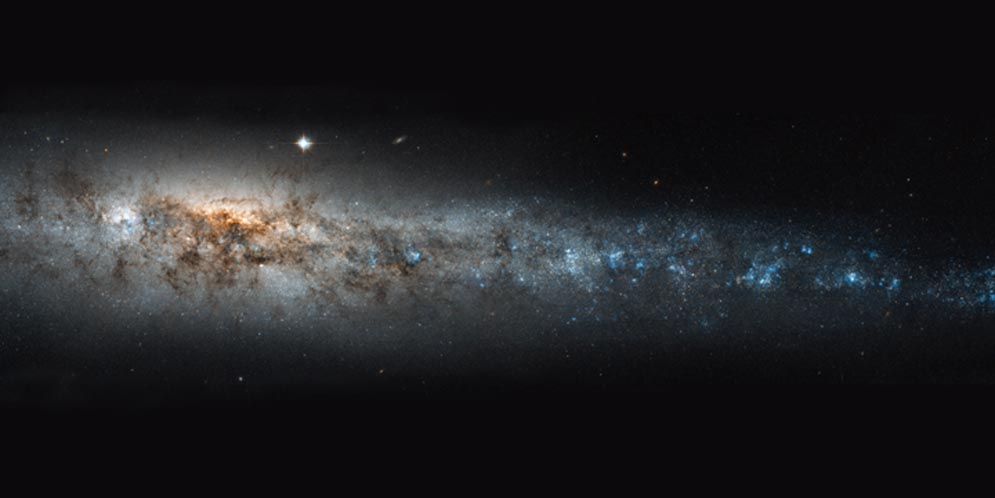
edge-on barred spiral galaxy
RA 12h 41m 58.19s Dec +32° 32? 21.23?
Canes Venatici
19 million light-years
9.8
15?.5 × 2?.7
7.44 x 2.03 arcminutes
North is 1.8° left of vertical
NASA & ESA
November 14, 2011
ABOUT THIS IMAGE:
The NASA/ESA Hubble Space Telescope has peered deep into NGC 4631, better known as the Whale Galaxy. Here, a profusion of starbirth lights up the galactic centre, revealing bands of dark material between us and the starburst. The galaxy’s activity tapers off in its outer regions where there are fewer stars and less dust, but these are still punctuated by pockets of star formation.
The Whale Galaxy is about 30 million light-years away from us in the constellation of Canes Venatici (The Hunting Dogs) and is a spiral galaxy much like the Milky Way. From our vantage point, however, we see the Whale Galaxy edge-on, seeing its glowing centre through dusty spiral arms. The galaxy's central bulge and asymmetric tapering disc have suggested the shape of a whale or a herring to past observers.
Many supernovae — the explosions of hot, blue, short-lived stars at least eight times the mass of the Sun — have gone off in the core of the Whale Galaxy. The stellar pyrotechnics have bathed the galaxy in hot gas, visible to X-ray telescopes like ESA’s XMM–Newton. Comparing the optical and near-infrared observations from Hubble with other telescopes sensitive to different wavelengths of light helps astronomers gather the full story behind celestial phenomena.
From such work, the triggers of the starburst in the Whale Galaxy and others can be elucidated. The gravitational "feeding" on intergalactic material, as well as clumping caused by the gravitational interactions with its galactic neighbours, creates the areas of greater density where stars start to coalesce. Just as blue whales, the biggest creatures on Earth, can gorge themselves on comparatively tiny bits of plankton, so the Whale Galaxy has become filled with the gas and dust that powers a high rate of star formation.
From Wikipedia:
NGC 4631 (also known as the Whale Galaxy or Caldwell 32) is a barred spiral galaxy in the constellation Canes Venatici. It was discovered on March 20, 1787 by William Herschel. This galaxy's slightly distorted wedge shape gives it the appearance of a herring or a whale, hence its nickname. Because this nearby galaxy is seen edge-on from Earth, professional astronomers observe this galaxy to better understand the gas and stars located outside the plane of the galaxy.
NGC 4631 contains a central starburst, which is a region of intense star formation. The strong star formation is evident in the emission from ionized hydrogen and interstellar dust heated by the stars formed in the starburst. The most massive stars that form in star formation regions only burn hydrogen gas through fusion for a short period of time, after which they explode as supernovae. So many supernovae have exploded in the center of NGC 4631 that they are blowing gas out of the plane of the galaxy. This superwind can be seen in X-rays and in spectral line emission. The gas from this superwind has produced a giant, diffuse corona of hot, X-ray emitting gas around the whole galaxy.
NGC 4631 has a nearby companion dwarf elliptical galaxy, NGC 4627. NGC 4627 and NGC 4631 together were listed in the Atlas of Peculiar Galaxies as an example of a "double galaxy" or a galaxy pair.
NGC 4631 and NGC 4627 are part of the NGC 4631 Group, a group of galaxies that also includes the interacting galaxies NGC 4656 and NGC 4657. However, exact group identification is problematic because this galaxy and others lie in a part of the sky that is relatively crowded. Estimates of the number of galaxies in this group range from 5 to 27 and all studies identify very different member galaxies for this group.